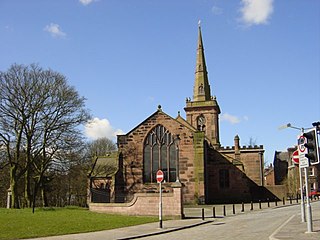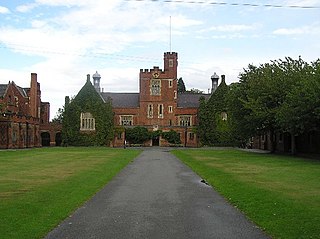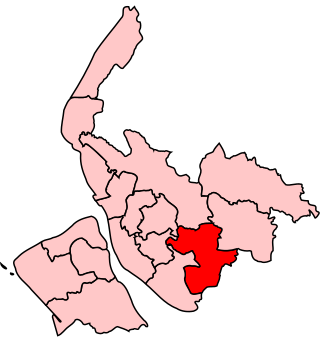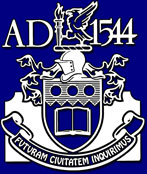
Prescot is a town and civil parish within the Metropolitan Borough of Knowsley in Merseyside, United Kingdom. It lies about eight miles (13 km) to the east of Liverpool city centre. At the 2001 Census, the civil parish population was 11,184. The population of the larger Prescot East and West wards at the 2011 census totalled 14,139. Prescot marks the beginning of the A58 road which runs through to Wetherby, near Leeds in West Yorkshire. The town is served by Prescot railway station and Eccleston Park railway station in neighbouring Eccleston.

The Metropolitan Borough of Knowsley is a metropolitan borough in Merseyside, North West England. It covers several towns and villages, including Kirkby, Prescot, Huyton, Whiston, Halewood, Cronton and Stockbridge Village; Kirkby, Huyton, and Prescot being the major commercial centres. It takes its name from the village of Knowsley, though its headquarters are in Huyton. It forms part of the wider Liverpool City Region.

Huyton is a town in the Metropolitan Borough of Knowsley, Merseyside, England. Part of the Liverpool Built-up Area, it borders the Liverpool suburbs of Dovecot, Knotty Ash and Netherley.

Rainhill is a village and civil parish in the Metropolitan Borough of St Helens, Merseyside, England. The population at the 2011 census was 10,853.

Loughborough Grammar School is a 10–18 private boys' school in the town of Loughborough, Leicestershire, England, founded in 1495 by Thomas Burton. Today, roughly one in ten boys at the school are boarders, with the remainder being day students. It is one of five schools known as the Loughborough Schools Foundation, along with Loughborough High School, Fairfield Preparatory School, Loughborough Amherst School and Loughborough Nursery.

Penistone Grammar School (PGS) is a large co-educational secondary school with a sixth form located in Penistone, South Yorkshire, England.

Whiston is a town and civil parish within the Metropolitan Borough of Knowsley in Merseyside, England. Previously recorded within the historic county of Lancashire, it is located eight miles east of Liverpool. The population was 13,629 at the 2001 Census, increasing to 14,263 at the 2011 Census.

Knowsley South was a constituency in Merseyside, represented in the House of Commons of the Parliament of the United Kingdom. It elected one Member of Parliament (MP) by the first past the post system of election.
The Becket School is a co-educational secondary Catholic school with academy status in West Bridgford, Nottinghamshire, England. It was formed in 1976 by the amalgamation of two schools, Corpus Christi Bi-Lateral School and Becket Grammar School for Boys. It is one of three Catholic secondary schools in the Greater Nottingham area, along with Christ the King and Trinity School.

Calderstones School is an English comprehensive school located opposite Calderstones Park on Harthill Road in the Liverpool suburb of Allerton.
The West Bridgford School is a co-educational comprehensive school with academy status in West Bridgford, Nottinghamshire, England.

St. Helens South and Whiston is a constituency created in 2010 represented in the House of Commons of the UK Parliament since 2015 by Marie Rimmer of the Labour Party.

Knowsley is a constituency represented in the House of Commons of the UK Parliament since 2024 by Anneliese Midgley of the Labour Party..
Outwood Academy City is a co-educational secondary school with academy status located on Stradbroke Road in Sheffield, South Yorkshire, England.

St Mary's College was a school in Blackburn, Lancashire, England, from 1925 to 2022. It was established in 1925 by the Marist Fathers as a Catholic boys grammar school. It later became a sixth form college. The college closed on 1 August 2022.

Oasis Academy Wintringham is a secondary school (academy) on Weelsby Avenue in Grimsby, North East Lincolnshire, England. It is just off the A16 Peaks Parkway just south-west of the A46 crossroads next to the Lisle Marsden CE Primary School in Wellow and on the Grimsby-Cleethorpes boundary. The school was originally a religious foundation, and lies in the ecclesiastical parish of St Augustine of Hippo.
Northgate High School is a co-educational secondary school situated in north Ipswich, Suffolk, England. It is a co-educational comprehensive school, for ages 11–16, and 16–18 in the Sixth Form Department. It has approximately 1736 children on roll.

Marple Hall School is a secondary school located in Marple, Greater Manchester.

Maltby Academy is an academy school in the former mining town of Maltby in South Yorkshire, England.

Whiston Hospital is an acute general hospital in Whiston, Merseyside, though its postal address places it in adjacent Prescot. The hospital is managed by Mersey and West Lancashire Teaching Hospitals NHS Trust.

















